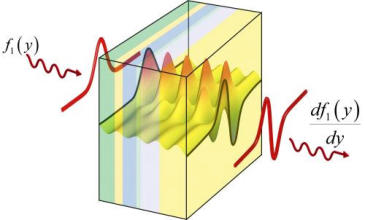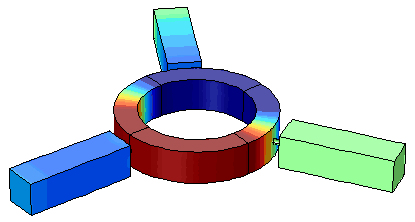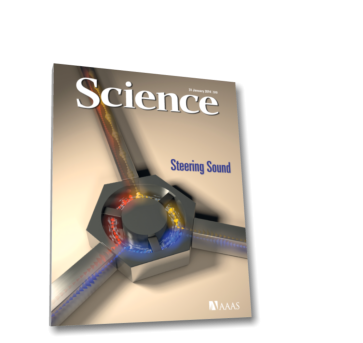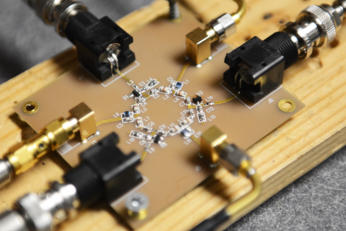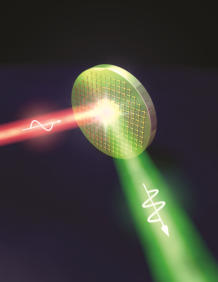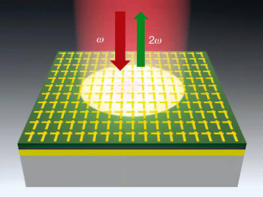




RESEARCH HIGHLIGHTS (3/8)

Computational Metamaterials
Optical signal processing of light waves can produce certain mathematical functions and
perform computational tasks on signals or images in an analog fashion. However, the
complex systems of lenses and filters required in conventional Fourier optics systems are
generally bulky. We have shown that metamaterials can perform similar optical processing
operations but with materials that need only be a wavelength thick. Our concept shows that
compact metamaterial structures can be designed to perform a suite of mathematical
functions, realizing ultrathin data processors, optical computers and even equation solving
‘on-the-fly’, as wave propagates through the metamaterial.
To learn more:
A. Silva*, F. Monticone*, G. Castaldi, V. Galdi, A. Alù, and N. Engheta, “Performing Mathematical Operations with Metamaterials,” Science, Vol. 343. No. 6167, pp. 160-163, January
10, 2014. (web)
A. Sihvola, “Enabling Optical Analog Computing with Metamaterials,” Science, Vol. 343, No. 6167, pp. 144-145, January 10, 2014.
“Researchers Lay Out Theory for Metamaterials that Act as an Analog Computer,” UT Austin Press Release, Phys.org, January 10, 2014.
J. Aoron, “First Light-Bending Calculator Designed with Metamaterials,” New Scientist, January 10, 2014.
A Circulator for Sound
The control of sound transmission is desirable in a number of circumstances from noise suppression to
imaging technologies. We have presented the first-of-its-kind nonreciprocal circulator for acoustic waves, a
subwavelength meta-atom made of a resonant ring cavity biased by an internally circulating fluid. The
direction of rotational flow of the fluid (air) changes the resonant properties of the ring cavity, allowing the
propagation of sound waves within the cavity to be controlled. With several ports connected to the cavity,
sound can be directed to a certain port in one direction, while isolating transmission in the reserve direction.
In the figure (cover of Science) he arrows represent acoustic signals flowing through the device (diameter: ~20
centimeters), which circulates sound in a nonreciprocal fashion: Signals can flow from left to top, from top to right,
and from right to left, but not in the opposite directions. This creates one-way communication channels for sound,
allowing listeners to hear but not be heard in return.
To learn more:
C. Q. Choi, “A One-Way Street for Sound,” Scientific American, Vol. 310, No. 4, p. 31, April 1, 2014.
M. Largey, “Creating a One-Way Mirror for Sound,” Radio Interview on KUT News, February 28, 2014.
C. Winter, “One-Way Sound Transmission,” Bloomberg Businessweek, February 20, 2014.
Longhorn Extra: Campus Minute, February 6, 2014.
A. Wood, “World first acoustic circulator puts sound on a one-way street,” Gizmag, February 5, 2014.
A. Dangelis, “Device Lets You Hear Without Being Heard,” Discovery News, February 5, 2014
M. Passarello, “La macchina per il suono «a senso unico»,” Il Sole 24 Ore, February 5, 2014.
V. Woollaston, “The Audio invisibility cloak: One-way sound device could let spies listen in on people without being heard,” Daily Mail, February 2, 2014.
“Da Invisible a Inaudibile,” La Repubblica, January 31, 2014.T. Commissariat, “Sound follows one direction,” Physics World, January 31, 2014.
R. Fleury, D. L. Sounas, C. F. Sieck, M. R. Haberman, and A. Alù, “Sound Isolation and Giant Linear Nonreciprocity in a Compact Acoustic Circulator,” Science, Vol. 343, No. 6170,
pp. 516-519, January 31, 2014. (web)
T. Ghose, “Spies, Take Note: Scientists Create One-Way Sound Machine,” NBC News, Live Science, January 30, 2014.
S. Zaragoza, “Engineers Build First Nonreciprocal Acoustic Circulator: A One-Way Sound Device,” UT Austin Press Release, Phys.org, Science Daily, January 30, 2014
S. Cummer, “Selecting the Direction of Sound Transmission,” Science, Vol. 343, No. 6170, pp. 495-496, January 31, 2014.
B. Ferreria, “To Eliminate Feedback, Engineers Invented the Acoustic Equivalent of One-Way Glass,” Motherboard, January 31, 2014.
A Magnetic-Free Radio-Wave Circulator on a Chip
We have recently created a radically smaller, more efficient, magnetic-free radio wave circulator that could be
used in cellphones and other wireless devices. The new circulator has the potential to enable full-duplex
functionality, meaning that devices can transmit and receive signals on the same frequency band at the same
time. Since the advent of wireless technology 60 years ago, magnetic-based circulators have been in principle
able to provide two-way communications on the same frequency channel, but they are not widely adopted
because of the large size, weight and cost associated with using magnets and magnetic materials. Freed from a
reliance on magnetic effects, the new circulator has a much smaller footprint while also using less expensive
and more common materials. These cost and size efficiencies could lead to the integration of circulators within
cellphones and other microelectronic systems, resulting in substantially faster downloads, fewer dropped calls
and significantly clearer communications.
Our prototype circulator that is 2 centimeters in size — more than 75 times smaller than the wavelength of
operation. The circulator may be further scaled down to as small as a few microns. The design is based on
materials widely used in integrated circuits such as gold, copper and silicon, making it easier to
integrate in the circuit boards of modern communication devices.
The device works by mimicking the way magnetic materials break the symmetry in wave
transmission between two points in space, a critical function that allows magnetic circulators to
selectively route radio waves in a non-reciprocal fashion. With the new circulator, we
accomplish the same effect, but replacing the magnetic bias with a traveling wave spinning
around the device.
Another unique feature is that the new circulator can be tuned in real time over a broad range of
frequencies, a major advantage over conventional circulators. Additionally, because the design
of the circulator is scalable and capable of circuit integration, it can potentially be placed in
wireless devices.
The circulator also could benefit other industries that currently use magnetic-based circulators. For instance, circulators used in phased arrays
and radar systems for aircraft, ships and satellites can be extremely heavy and large, so minimizing the size of these systems could provide
significant savings.
We are also bringing this paradigm to other areas of science and technology. Our research team is working on using this concept to protect
lasers and to create integrated nano-photonic circuits that route light signals instead of radio waves in preferred directions.
To learn more:
N. Estep*, D. Sounas*, J. Soric, and A. Alù, “Magnetic-Free Non-Reciprocity Based on Parametrically Modulated Coupled-Resonator Loops,” Nature Physics, in press. (web)
T. Simonite, “Simple Circuit Could Double Cell Phone Data Speeds,” MIT Technology Review, November 24, 2014.
S. Zaragoza, “Lighter, Cheaper Radio Wave Device Could Transform Telecommunications,” UT Austin Press Release, Phys.org, November 10, 2014
A. Sihvola, “Device physics: Power inequality,” Nature Physics, in press.
Meta-Mirror with Giant Nonlinear Response
Our group, in collaboration with the group of M. Belkin in our department and TU Munich, has created a new
nonlinear metasurface, or meta mirror with giant nonlinear response, that could one day enable the
miniaturization of laser systems. The metamaterial has a nonlinear optical response a million times as strong as
traditional nonlinear materials, and demonstrated frequency conversion in films 100 times as thin as human
hair using light intensity comparable with that of a laser pointer.
Nonlinear optical effects are widely used by engineers and scientists to generate new light frequencies, perform
laser diagnostics and advance quantum computing. Due to the small extent of optical nonlinearity in naturally
occurring materials, high light intensities and long propagation distances in nonlinear crystals are typically
required to produce detectable nonlinear optical effects.
This work opens a new paradigm in nonlinear optics by exploiting the unique combination of exotic wave
interaction in metamaterials and of quantum engineering in semiconductors. The metamaterial at the
basis of this unusual optical response consists of a sequence of thin layers made of indium, gallium and
arsenic on the one hand and aluminum, indium and arsenic on the other. Our team stacked
approximately 100 of these layers, each between 1 nanometer and 12 nanometers thick, and sandwiched
them between a layer of gold at the bottom and a pattern of asymmetric gold nanocrosses on top. The
thin semiconductor layers confine electrons into desired quantum states, and gold nanocrosses resonate
at input and output frequencies to enable the the nonlinear optical response of the mirror. The realized
mirror converts light from a wavelength of 8 micrometers to 4 micrometers; however, the structures can
be tailored to work at other wavelengths, from near-infrared to mid-infrared to terahertz.
Alongside frequency doubling, our structures may be designed for sum- or difference-frequency
generation, as well as a variety of four-wave mixing processes, and our work unveils a pathway towards the development of ultrathin, highly
nonlinear optical elements for efficient frequency conversion that will operate without stringent phase-matching constraints of bulk nonlinear
crystals.
To learn more:
J. Lee, M. Tymchenko, C. Argyropoulos, P. Y. Chen, F. Lu, F. Demmerle, G. Boehm, M. C. Amann, A. Alù, and M. A. Belkin, “Giant Nonlinear Response from Plasmonic
Metasurfaces Coupled to Intersubband Transitions,” Nature, Vol. 511, No. 7507, pp. 65-69, July 2, 2014. (web)
S. Zaragoza, “Researchers Invent ‘Meta Mirror’ to Help Advance Nonlinear Optical Systems”, UT Austin Press Release, July 2, 2014.
”Highly non-linear metamaterials for laser technology - a million times better”, Nanowerk.com, July 2, 2014



